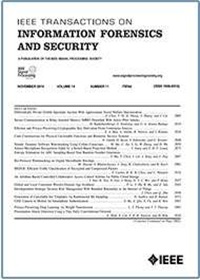LightGBM-Based Audio Watermarking Robust to Recapturing and Hybrid Attacks
IF 6.3
1区 计算机科学
Q1 COMPUTER SCIENCE, THEORY & METHODS
IEEE Transactions on Information Forensics and Security
Pub Date : 2025-04-09
DOI:10.1109/TIFS.2025.3559408
引用次数: 0
Abstract
Digital audio watermarking is a critical technology widely used for copyright protection, content authentication, and broadcast monitoring. However, its robustness is significantly challenged by recapturing and hybrid attacks, which can easily remove watermarks. To address this issue, this work proposes a novel scheme based on the light gradient boosting machine (LightGBM), named LRAW (LightGBM-based Robust Audio Watermarking), which is designed to increase the robustness of audio watermarking against various attacks. Specifically, the scheme begins by analysing coefficients derived from the discrete wavelet transform (DWT), graph-based transform (GBT), and singular value decomposition (SVD). The extracted singular values consistently maintain a stable descending order even under recapturing attacks at a slightly greater distance. Leveraging this stability, the watermark information is implicitly embedded into the audio signal using a quantization rule. To simulate a hybrid attack scenario, a comprehensive feature dataset comprising 396,000 pieces of DWT-GBT-SVD feature data is constructed based on 60 original recordings and 9 types of attack. Furthermore, considering the distinct influences of embedding watermark bits 0 and 1 on the quantization of singular values, the watermark extraction process is formulated as a binary classification problem. LightGBM is trained using Bayesian optimization and the feature dataset to classify the watermark bits accurately. Finally, the complete watermark is recovered using a watermark sequence matching algorithm. Theoretical analysis and experimental results demonstrate that the proposed LRAW scheme outperforms state-of-the-art watermarking methods in robustness against various recapturing and hybrid attacks, even when the distance between the acoustic source and the receiver is considerable.基于lightgbm的音频水印对重捕获和混合攻击的鲁棒性
数字音频水印技术在版权保护、内容认证、广播监控等领域有着广泛的应用。然而,它的鲁棒性受到重捕获和混合攻击的显著挑战,这些攻击可以很容易地去除水印。为了解决这个问题,本工作提出了一种基于光梯度增强机(LightGBM)的新方案,称为LRAW(基于LightGBM的鲁棒音频水印),旨在提高音频水印对各种攻击的鲁棒性。具体来说,该方案首先分析离散小波变换(DWT)、基于图的变换(GBT)和奇异值分解(SVD)得出的系数。即使在距离稍远的重夺攻击下,提取的奇异值也始终保持稳定的降序。利用这种稳定性,使用量化规则将水印信息隐式嵌入音频信号中。为了模拟混合攻击场景,基于60条原始录音和9种攻击类型,构建了包含39.6万条DWT-GBT-SVD特征数据的综合特征数据集。此外,考虑到嵌入水印比特0和1对奇异值量化的不同影响,将水印提取过程表述为二值分类问题。利用贝叶斯优化和特征数据集训练LightGBM,对水印位进行准确分类。最后,利用水印序列匹配算法恢复完整的水印。理论分析和实验结果表明,即使声源和接收器之间的距离相当大,所提出的LRAW方案在抗各种重捕获和混合攻击方面的鲁棒性优于最先进的水印方法。
本文章由计算机程序翻译,如有差异,请以英文原文为准。
求助全文
约1分钟内获得全文
求助全文
来源期刊

IEEE Transactions on Information Forensics and Security
工程技术-工程:电子与电气
CiteScore
14.40
自引率
7.40%
发文量
234
审稿时长
6.5 months
期刊介绍:
The IEEE Transactions on Information Forensics and Security covers the sciences, technologies, and applications relating to information forensics, information security, biometrics, surveillance and systems applications that incorporate these features
 求助内容:
求助内容: 应助结果提醒方式:
应助结果提醒方式:


